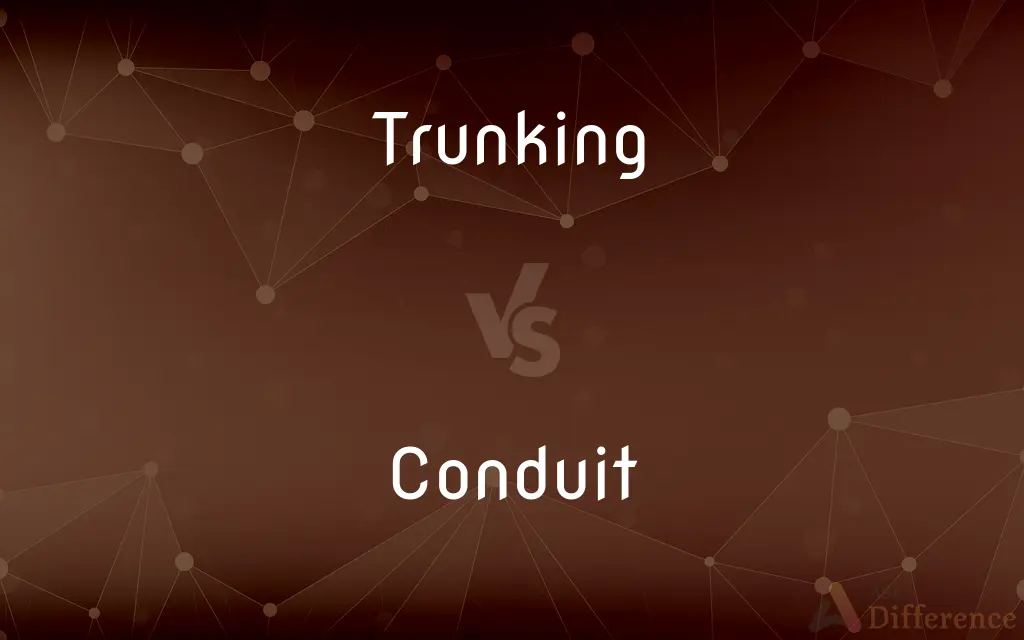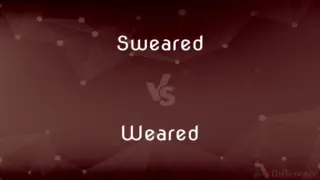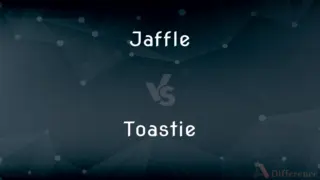Trunking vs. Conduit — What's the Difference?
By Tayyaba Rehman — Updated on October 6, 2023
Trunking is a system for enclosing cables in buildings, while Conduit refers to tubes that protect and route electrical wiring. Both aid in organizing and protecting wires.

Difference Between Trunking and Conduit
Table of Contents
ADVERTISEMENT
Key Differences
Trunking is primarily an enclosure system that houses and organizes cables, often seen in office environments or data centers. Its main focus is to keep multiple cables tidy and easily accessible. Conduit, on the other hand, is a tube or tunnel-like structure, typically made of metal or plastic, designed to protect and route electrical wires.
While both Trunking and Conduit serve the purpose of housing cables or wires, their application differs. Trunking systems are generally surface-mounted and might be visible, providing ease of access to cables for maintenance or reconfiguration. Conduits, conversely, are often embedded within walls, floors, or ceilings, making the wires they contain less accessible but more protected.
From a material perspective, Trunking systems can be made of various materials, including metal, plastic, or wood. They often come with removable covers to access the cables inside. Conduit is typically made of rigid or flexible metal, PVC, or other durable materials that ensure the protection of the wires inside from external damages.
Aesthetic considerations also differ between Trunking and Conduit. While Trunking is designed for easy accessibility and can be seen in modern office environments, it might not always be the most aesthetically pleasing. Conduit systems, being concealed within structures, offer a more polished look, keeping wires entirely out of sight.
Lastly, the term Trunking also finds use in telecommunications to refer to a method where multiple signals are bundled together. Conduit remains specific to its definition, referring to the protective tubing for electrical or communication cables.
ADVERTISEMENT
Comparison Chart
Primary Use
Organizing and enclosing multiple cables.
Protecting and routing individual wires.
Visibility
Often surface-mounted and visible.
Usually concealed within walls or structures.
Material
Metal, plastic, wood.
Metal, PVC, or other durable materials.
Aesthetic
Functional, may be seen in modern environments
Offers a polished look, keeping wires concealed.
Other Uses
Used in telecom for bundling signals.
Specific to protective tubing for cables.
Compare with Definitions
Trunking
An enclosure system for cables.
The office used trunking to organize its many computer cables.
Conduit
Often embedded within structures.
The conduit inside the wall protected the wires from any damage.
Trunking
Often surface-mounted and accessible.
The trunking on the wall allowed easy access to the cables.
Conduit
A tube for protecting electrical wires.
The electrician installed a conduit to route the new wiring.
Trunking
Also a telecom term for bundling signals.
The company adopted trunking techniques to manage its communications better.
Conduit
Made of durable materials like metal or PVC.
The metal conduit ensured the safety of the electrical wires.
Trunking
A system to keep cables tidy.
Trunking systems are common in data centers for cable management.
Conduit
Keeps wires concealed and tidy.
Using a conduit, the renovation looked clean without any visible wires.
Trunking
Can be made of various materials.
The plastic trunking in the conference room was durable and neat.
Conduit
Specifically for protective tubing.
The construction plan included a conduit system for all electrical setups.
Trunking
In telecommunications, trunking is a technology for providing network access to multiple clients simultaneously by sharing a set of circuits, carriers, channels, or frequencies, instead of providing individual circuits or channels for each client. This is reminiscent to the structure of a tree with one trunk and many branches.
Conduit
A channel for conveying water or other fluid
Nearby springs supplied the conduit which ran into the brewery
Trunking
All the electrical and communications cables bundled together and distributed through a building.
Conduit
A tube or trough for protecting electric wiring
The gas pipe should not be close to any electrical conduit
The cable must be protected by conduit
Trunking
(business) The movement of containers or packages between a terminal and a transporter's inland facilities, or the scheduled transportation service between locations.
Conduit
A pipe or channel for conveying fluids, such as water.
Trunking
(UK) A system of ducts for cables, heating or ventilation.
Conduit
A tube or duct for enclosing electric wires or cable.
Trunking
(UK) Plastic conduit or duct used to conceal and protect electrical wiring.
Conduit
A means by which something is transmitted
An arms dealer who served as a conduit for intelligence data.
Trunking
A two-way radio technique that uses a control channel to automatically assign frequency channels to groups of user radios.
Conduit
(Archaic) A fountain.
Trunking
Present participle of trunk
Conduit
A pipe or channel for conveying water etc.
Conduit
A duct or tube into which electrical cables may be pulled; a type of raceway.
Conduit
(figurative) A means by which something is transmitted.
The medium considered herself a conduit for messages from the spirit world.
Conduit
(finance) An investment vehicle that issues short-term commercial paper to finance long-term off-balance sheet bank assets.
Conduit
A pipe, canal, channel, or passage for conveying water or fluid.
All the conduits of my blood froze up.
This is the fountain of all those bitter waters, of which, through a hundred different conduits, we have drunk.
Conduit
A structure forming a reservoir for water.
Conduit
A narrow passage for private communication.
Conduit
A passage (a pipe or tunnel) through which water or electric wires can pass;
The computers were connected through a system of conduits
Common Curiosities
Is Trunking always visible?
While trunking is often surface-mounted and visible, some types might be concealed.
What materials are Trunking systems made from?
Trunking can be made from metal, plastic, wood, or other materials.
Can I access wires easily in Trunking?
Yes, trunking is designed for easy accessibility to cables for maintenance or changes.
Can Trunking systems be customized?
Yes, trunking systems come in various sizes and configurations to suit different needs.
Is Conduit always made of metal?
No, conduit can be made of metal, PVC, or other durable materials.
Is Trunking only used for electrical cables?
No, trunking can be used for various types of cables, including data, telecom, and more.
Does Trunking have applications in telecommunications?
Yes, trunking also refers to a method in telecom where multiple signals are bundled together.
Can Conduit be used outside buildings?
Yes, conduits can be used both indoors and outdoors for wire protection.
Do Conduit systems improve aesthetics?
Yes, since conduits are often concealed, they offer a tidy appearance by keeping wires out of sight.
What is Trunking?
Trunking is an enclosure system designed to house and organize cables, especially in buildings.
How does Conduit differ from Trunking?
Conduit is a tube-like structure made to protect and route electrical or communication wires, often within walls.
Why use a Conduit over just laying wires?
Conduits offer protection to wires from external damages, moisture, and other hazards.
How does Conduit benefit construction projects?
Conduits provide a structured way to lay and protect wires, ensuring safety and neatness.
Are both Trunking and Conduit necessary for modern constructions?
While not always necessary, both offer advantages in safety, organization, and aesthetics in modern construction projects.
In which environments is Conduit most commonly used?
Conduits are common in residential, commercial, and industrial settings for wire protection.
Share Your Discovery

Previous Comparison
Sweared vs. Weared
Next Comparison
Jaffle vs. ToastieAuthor Spotlight
Written by
Tayyaba RehmanTayyaba Rehman is a distinguished writer, currently serving as a primary contributor to askdifference.com. As a researcher in semantics and etymology, Tayyaba's passion for the complexity of languages and their distinctions has found a perfect home on the platform. Tayyaba delves into the intricacies of language, distinguishing between commonly confused words and phrases, thereby providing clarity for readers worldwide.















































